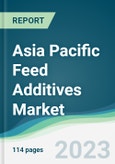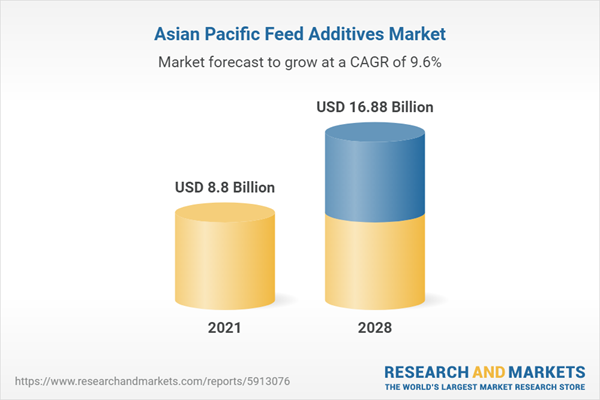The Asia Pacific feed additives market is evaluated at US$8.799 billion for the year 2021 growing at a CAGR of 9.57% reaching the market size of US$16.880 billion by the year 2028.
The Asia Pacific market is one of the dominating regions in the global feed additives market. The consumption of seafood and aqua feed utilization in China is one of the reasons for increasing feed additives in the projected period. Besides this, the increasing use of feed additives by farmers to prevent livestock to prevent them from diseases and to provide them with the nutritional content of animal-derived products for human consumption is increasing the production of animal feed in the Asia Pacific region. According to, the United States Department (USDA) of Agriculture the consumption of carabeef and beef was forecasted to be 2.9 million metric tons in 2022 and was increased by 5% from the previous year. The increasing consumption of meat is an increase in all around Asia Pacific is propelling the market growth for feed additives in the region.The Increasing Use Of Feed Additives In The Region
The increasing per-capita meat consumption in the region coupled with the adoption of new and innovative animal husbandry practices in countries such as China, Japan, and India are pushing the market in an upward direction in the forecast period. Furthermore, the increasing health concerns in consuming meat are also increasing the market growth. In addition, things like the modernization of retail patterns, the expansion of fast-food chains, and favourable demographics draw participants from all over the world, promoting market expansion. Feed additives are also used to increase milk production in countries like India where milk is one of the majorly used animal products.According to National Dairy Development Board, the production of milk in India in 2021-22 was 221.1 million tons, and the per capita availability of milk for the population was 444 grams/ day in the same year. The increasing milk production in India and increasing meat consumption are making India one of the major markets in the projected period.
Additionally, according to the Australian Bureau of Agricultural and Resource Economics and Sciences (ABARES), Australians will consume an average of 50.1 kg of chicken meat per person in 2022–2023. In countries like China also meat consumption is increasing for instance, as per the USDA, pork consumption in China was 57 million tons in 2021, which is 60% of the total meat consumed by the country. Such increases are anticipated to increase the market for feed additives as it increases the nutritional content of the animal.
India is expected to dominate the market
The market is being driven by several key factors, including the rising adoption of contemporary animal husbandry practices, emerging technological advancement in feed additive formulations, and the implementation of beneficial government programs to support livestock development.As per the Animal Husbandry Department (Government of Uttar Pradesh) data, swine meat production increased from 57.96 lac kg. in 2019-20 to 481.9 lac kg. in the year 2020-21. The swine meat production further surged to 653.50 lac kg. in 2021-2022 owing to the increase in utilization of feed additives.
To improve animal nutrition, health, and welfare while assuring food safety and environmental sustainability, the Indian government has launched several projects. The launch of many programs for the development of livestock that provide farmers and livestock producers with financial incentives, subsidies, and technical support is also having an impact on the market's expansion. To increase animal output, these programs promote the use of cutting-edge animal husbandry techniques, such as the use of high-quality feed additives.
Key Developments
- In October 2022Evonik and BASF collaborated where, BASF gave Evonik some non-exclusive licencing rights to OpteinicsTM, a technological advancement that will help people understand the animal protein and feed industries better and lessen their environmental impact.
- In December 2022, the Adisseo group agreed to buy Nor-Feed and its subsidiaries to develop and register botanical additions for use in animal feed.
- To improve animal nutrition, Delacon and Cargill worked together to launch a worldwide plant-based phytogenic feed additives businessin June 2022.The relationship has contributed to a growth in the company's footprint in India and substantial feed additives knowledge.
- In January 2022, DSM and Novozymes announced that Hiphorius is a new generation of phytase. It is an all-inclusive phytase solution designed to help poultry farmers generate profitable and long-lasting protein which will be made available in India.
- In March 2023, DSM unveiled the Digital SalmoFanTM, a colour measurement instrument. ADM and Air Protein inked a strategic partnership in May 2023 to expedite the creation of a special protein that may be raised without a land base.
Segmentation:
By Product Type
- Antibiotics
- Enzyme
- Vitamin
- Animo Acid
- Antioxidants
- Acidifiers
- Minerals
- Others
By Livestock
- Aquatic Animals
- Poultry
- Swine
- Cattle
- Others
By Country
- Japan
- China
- Australia
- India
- South Korea
- Taiwan
- Thailand
- Indonesia
- Others
Table of Contents
1. INTRODUCTION
2. RESEARCH METHODOLOGY
3. EXECUTIVE SUMMARY
4. MARKET DYNAMICS
5. ASIA PACIFIC FEED ADDITIVES MARKET ANALYSIS, BY PRODUCT TYPE
6. ASIA PACIFIC FEED ADDITIVES MARKET ANALYSIS, BY LIVESTOCK
7. ASIA PACIFIC FEED ADDITIVES MARKET ANALYSIS, BY COUNTRY
8. COMPETITIVE ENVIRONMENT AND ANALYSIS
9. COMPANY PROFILES
Companies Mentioned
- Cargill Incorporated
- BASF SE
- Novozymes
- Adisseo France SAS
- Nutreco
- Chr. Hansen
- Evonik Industries
- Archer Daniels Midland Company
- Alltech Inc
- Elanco Animal Health
Methodology

LOADING...
Table Information
| Report Attribute | Details |
|---|---|
| No. of Pages | 114 |
| Published | October 2023 |
| Forecast Period | 2021 - 2028 |
| Estimated Market Value ( USD | $ 8.8 Billion |
| Forecasted Market Value ( USD | $ 16.88 Billion |
| Compound Annual Growth Rate | 9.5% |
| Regions Covered | Asia Pacific |
| No. of Companies Mentioned | 10 |









